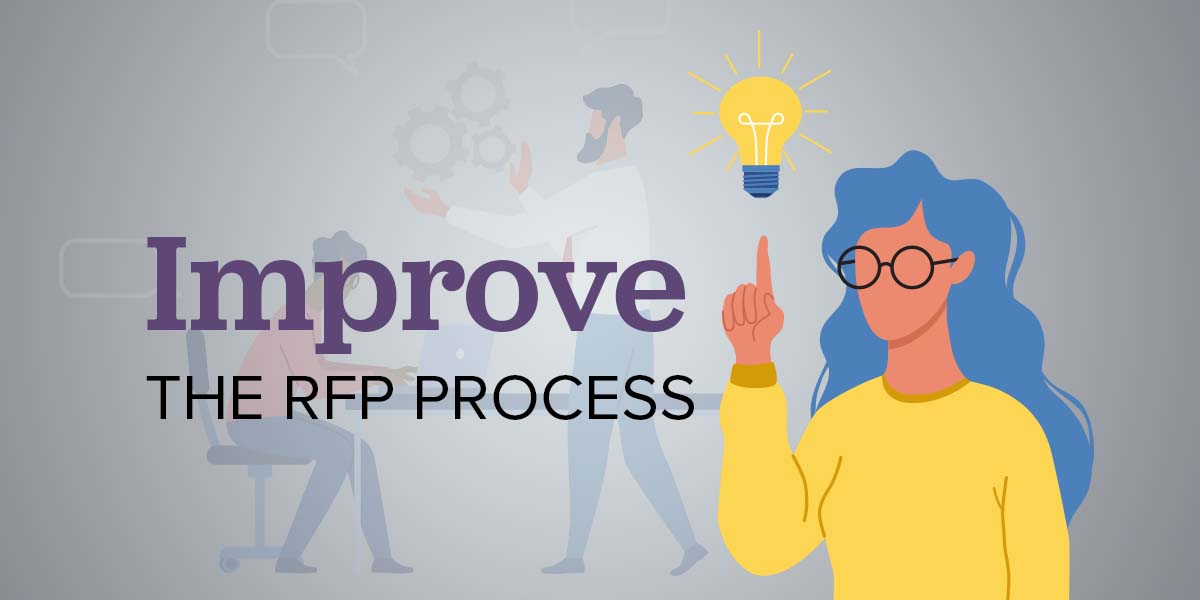
If you find the Request for Proposal (RFP) process tedious, you're not alone. Requesting proposals and weeding through them to find responses that meet your requirements can feel like a full-time job. Especially if you are part of a nonprofit organization and need a minimum of three competitive RFP bids for every request.
While we can't promise to make the RFP process less labor-intensive, we can give you some tips to make it go a bit more smoothly.
Planning for Your RFP
If you're going to take the time and effort to work through the RFP process, you'll want to refine it as much as possible to meet your specific needs.
1. Educate Yourself
Before starting the RFP process, do some research to find tools, platforms, and best practices to make things a little easier. Software tools and platforms can help tailor the RFP creation process so that you're not creating the wheel every time. Learning best practices will ensure your request is relevant and includes helpful information.
2. Avoid the "Everything but the Kitchen Sink" Approach
When your RFP includes everything, nothing in the responses will stand out. Instead, streamline your RFP to include only the functionality, features, and tools you're looking for. By removing anything non-essential, you make room for detail around the things you actually need.
3. Define the Relationship (With Your Vendor)
Take some time to consider what you're looking for in a relationship with your vendor. Do you want someone hands-off that will let you run with things but is there if you have a problem? Or are you looking for a vendor that will help you integrate the new tool and transfer your data over? Including whether you want a partnership or a more transactional relationship will help you find the right fit.
4. Determine How to Keep Score
It can be tempting to skip this, but it will only create more work and stress in the future. As you put together your RFP, consider how you will score the responses you receive. Are there specific factors or features that are more important than others? Is having a concierge service more valuable than a turnkey solution? Set a scale by which you can score your RFP responses to clearly and accurately assess them.

Writing Your RFP
Writing your RFP can be one of the most time-consuming parts of the process. Hopefully, by taking the time to plan, it comes together quickly.
5. Set Your Budget
When putting together your RFP, be sure to include a budget or range. It will not only state what you're willing to spend on the project but will help to weed out vendors that are too expensive. A set budget will limit the number of responses you get and will ensure that those received are worth consideration.
6. Ask Them to Show Their Work
You are taking the time to craft your RFP to find a good fit. One way to achieve that is by asking to see examples of work that is relevant to your organization or situation. Case studies and portfolio examples establish the credibility of the vendors responding to your RFP. They also help you understand what they do and how they do it so that you can see how the vendor may work with your nonprofit.
7. Create a Timeline
We know you don't want to find yourself in RFP-land forever! One way to avoid neverending RFP response collection and review is to create a timeline. Set a deadline for receiving RFP responses. This will let prospective vendors know when you would like their response and establishes a cutoff. Disregard any RFP responses received outside of your timeframe. Additionally, set a schedule for reviewing and scoring the RFP responses you get. This will prevent overwhelm and keep the process on track.
8. Get Valuable Insight
Setting up meetings to review the RFP with your internal team can help you gain valuable insight. Your colleagues can identify questions that a vendor may have and highlight areas that need clarification. They can also help you understand how the solution you're looking for may have value beyond your initial scope. For example, you may be looking for scheduling software. But, perhaps a CRM that also does scheduling may be more beneficial to the organization as a whole. Rather than worrying that opening up the conversation may slow you down, recognize that opening your mind may help you get more bang for your buck.

Scoring Your RFP
Once you've written your RFP and put it out there to prospective vendors, it's time to evaluate and score the responses you receive.
9. Use Your Scoring Rubric
In step four, we had you set up how to score your RFP responses. Now, it's time to put it to use. This way, you will be able to weigh and measure the responses and how they match your goals. Once you've mapped an RFP response to your scoring rubric, you can compare the scores to other responses and determine the best fit.
10. Get to Know Your Vendors
This step isn't mandatory, but it can help you feel more confident in your decision-making. Set up meetings with the vendors from your top RFP responses. This is an opportunity to ask clarifying questions, learn more about how they do business, and get a feel for the prospective partnership. It will also allow the vendor to better understand your organization's needs. While these meetings may not change your mind, they should let you know that you're making the right choice.
A Better RFP Process = Better RFP Results
Hopefully, these tips for improving the RFP process have helped you think through how to plan and create your RFP. By taking the time to create your RFP the right way, you will end up with better responses and the confidence of knowing that you've selected the right vendor for your organization.